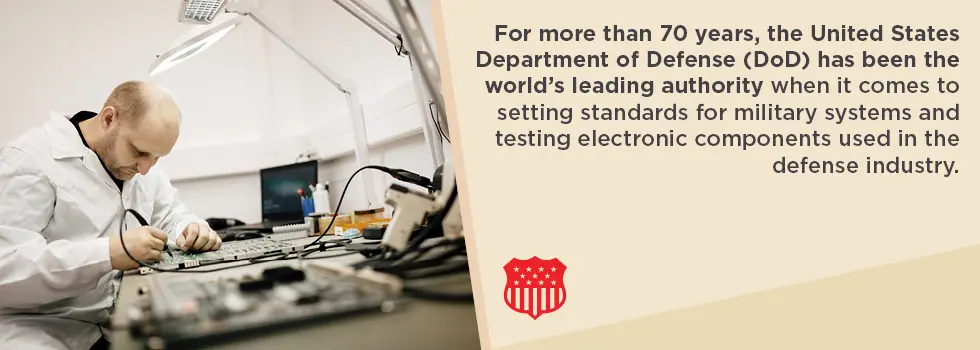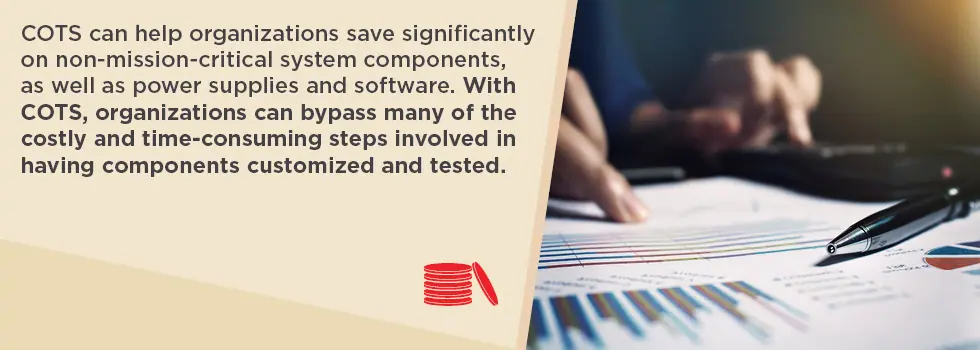

Commercial off-the-shelf (COTS) products offer alternatives to enterprises that need to purchase equipment, but wish to avoid having items engineered to specifications. For the U.S. military, the option of mil-COTS power supplies provides an alternative to application-specific machines and artillery. So what are COTS power supplies?
According to the U.S. Federal Acquisition Regulation, COTS are commercial products and services available for purchase under government contract. Examples of items and services classified as COTS include the following:
Items and services associated with commercial undertakings qualify as COTS, whereas cargo does not.
COTS gives organizations the option to buy products for a range of specialized purposes rather than have them made to order.
In theory, COTS are ready for use the moment they arrive. However, in the majority of applications, COTS must be configured to the unique demands of a given task or organization. Customization can extend the functionality of COTS, but it’s important to weigh the pros and cons of this option. COTS vendors generally won’t support such an option, and maintenance issues often arise when functionalities are customized.
Due to the procurement and maintenance savings organizations can reap by selecting COTS, various corporate and government entities use the option. COTS are widely recognized as an effective way to reduce the costs of operating a system over the life of an organization.
During the 1990s, COTS earned a reputation as an efficient way to lower the time-consuming and financially burdensome task of software development. With COTS software, organizations could slash their software overhead and reduce the development time required for software programs.
COTS software developers are usually independent vendors who sell their products and services to organizations. The general public can also buy, rent, or license COTS.
COTS software is developed by experts and verified for quality by various third-party organizations. As such, COTS software is generally more reliable than software developed in-house.
However, security risks can accompany the use of COTS software when it is integrated with a company’s pre-existing software network. The risks are even more pronounced when in-house software and COTS software are combined into new, composite software programs, as the composite can carry over problem issues that originate from incompatible COTS elements.

Despite the U.S. Department of Homeland Security sponsoring supply chain security efforts on matters pertaining to COTS, software industry watchdogs assert chain disruption issues remain a likely risk of composite applications with COTS software.
Medical industry professionals sometimes refer to COTS software as SOUP, which stands for software of unknown pedigree. The designation is based on the notion that software built with an unidentified development process is not reliable to use in medical devices. This is because faulty software components could potentially result in catastrophic system failure.
Components used in the military must undergo complex qualification tests over extended periods under harsh conditions.
As federal agencies look to balance their budgets both domestically and abroad, organizations are looking to slash spending on electrical components for select use areas. COTS can render non-critical applications in the military and aerospace sectors more economically efficient.

When a military device is altered in any capacity — even if this merely consists of a slight change in the material used in its production — the change can mandate a thorough set of testing to re-qualify the device all over again. With so much money invested in each device, organizations try their best to ensure these devices remain qualified for at least a decade or more.
The term COTS became familiar throughout the military and aerospace industries as organizations increasingly looked for ways to cut costs on electronic systems. While the term “commercial off-the-shelf” reveals that the products are not qualified for mission-critical use, COTS can still help organizations save untold sums of money and time in the testing and development of devices for non-critical use.
To optimize equipment for the most rigorous tasks and harshest conditions, manufacturers have sometimes overlooked other important areas of product endurance, such as a device’s ability to operate within the widest range of temperatures possible or its compatibility with an optimal range of power sources.
When designers are required to satisfy stricter standards and a wider range of operating conditions — from the hottest of temperatures to the most vibration-prone settings — a more rugged set of COTS devices are called upon to fill the demand. While such devices must still meet the “off-the-shelf” criteria, so to speak, they might also be used for a broader range of applications.
Industry experts often refer to this category of devices as COTS+. They fall short of high-reliability qualification, yet exceed the general use associated with off-the-shelf products.
For more than 70 years, the United States Department of Defense (DoD) has been the world’s leading authority when it comes to setting standards for military systems and testing electronic components used in the defense industry.
Reliable components have also played a key role in humans’ ability to conquer outer space, starting with the first manned missions in the 1960s and continuing through the present day with the International Space Station. The current industries of passenger air travel and satellites have both drawn from the technological advances originally made by NASA and the DoD.
Today, the use of COTS and COTS+ equipment is widely accepted among component manufacturers for the military and aerospace sectors. In applications that do not mandate the use of compliant parts, COTS makes it possible to implement applications much faster than processes would have allowed in earlier decades.
Over the past twenty years, the DoD has been adamant about the importance of COTS components in non-mission-critical applications. With COTS, the U.S. government can reduce its military system expenses and still maintain the strongest set of military operations among all industrialized nations worldwide. However, systems developed for military applications are generally expected to last two or more decades.
Throughout this time, the demands on a vast range of naval, airborne, and ground applications can be extremely harsh. As such, the development of COTS+ products has been an essential step toward integrating off-the-shelf components into systems that hold extremely rigorous standards, such as those held by the DoD.
The acceptance of COTS throughout the military and aerospace sectors has led to its adoption in civilian enterprises, such as the automotive industry. Given the cost and time benefits of commercial off-the-shelf supplies, organizations in a wide range of industries can now benefit from this option.

In industries such as mining and manufacturing, COTS can give you military-grade performance without the costs normally associated with military-grade equipment. Off-the-shelf products can help lower some of the costs behind the processes involved in producing goods and excavating minerals from the Earth’s soil.
COTS have also been a boon for offshore drilling. In a field that necessitates high budgets to carry out the gargantuan task of braving dangerous currents to tap resources from the land below the sea, any equipment that can help companies save money is of great benefit to the offshore drilling industry as a whole.
When providing power to industrialized systems, rugged versions of COTS components have often proven to be a viable alternative to application-specific components. Granted, applications of this nature generally require certain modifications to the standard COTS product, but the option has delivered cost benefits to organizations and allowed for a streamlining of key processes.
Modified COTS provides power to equipment from reputable vendors, whose products offer quality and reliability in all areas of the military and aerospace sectors, which demand a vast range of processes and arsenals. By employing military-grade expertise in design and engineering, qualified vendors have been able to offer the required power-supply components for some of the most grueling processes of the 21st century.
Vendors work in partnership with prime contractors and the managers of armed forces to keep the power supply of modified COTS exactly within the requirements of the applications specified and to keep everything within budget and completed according to set timetables.
The favored method of devising gainfully altered COTS AC-DC or DC-DC power sources is using regular AC-DC and DC-DC units, along with the vital circuitry for the specifications at hand. With this method, organizations can largely cut down on turnaround times and the problem of non-recurring engineering.
When it comes to modifying COTS, one of the most important courses of action for an organization is to find the proper vendor to implement the steps above. After all, power supplies are not always what they are cracked up to be after considering all the supporting factors.
Case in point: A manufacturer could advertise a module with a power density of more than 60 watts per cubic inch. However, that density might only be possible if an unlikely set of factors are also in place, such as low temperatures and precise voltage input/output levels. Consequently, the greatest power density a user is liable to get under normal conditions with the module in question might be somewhere in the range of 10 to 20 watts per cubic inch.
How does COTS compare to other power supply solutions regarding cost? COTS can help organizations save significantly on non-mission-critical system components, power supplies, and software. With COTS, organizations can bypass many of the costly and time-consuming steps in having customized and tested components.
How do COTS compare regarding ruggedization? COTS are versatile enough to face some of the most grueling demands in the military, aerospace, and industrial sectors. Designed to function in all kinds of situations, COTS can handle a vast range of harsh working environments and extreme temperatures.
How do COTS compare concerning implementation time? Commercial off-the-shelf products can be put to use upon arrival or shortly after a few minor modifications. Either way, COTS help organizations save valuable time and become more efficient.
What are the uses for COTS military-grade power supplies? COTS power supplies for ground vehicles and aircraft have been a boon for the military when it comes to powering equipment and systems. Likewise, COTS power supplies for communications have made it easier and more affordable for the military to implement vital tasks.
What are the uses for COTS power supplies in aerospace and other industries? COTS power supplies are used throughout the aerospace sector and also to power heavy equipment in the mining and offshore drilling industries.
When you need power supplies for heavy-duty operations, COTS are an efficient alternative to in-house built and engineered machines and equipment. COTS are reliable for various tasks in military and industrial settings. Best of all, organizations save time and money that the construction and testing of customized supplies would otherwise consume.
With more than 35 years of experience in the military sector, Advanced Conversion Technology (ACT) has developed a wide array of COTS AC-DC and DC-DC power sources equipped to suit several different applications. ACT COTS military supplies can be tailored to suit a variety of needs, whether frame-mounted, rack-mounted, or conventionally packaged.

With optimal AC-DC and DC-DC power supplies, ACT COTS supplies can fulfill advanced levels and revisions in military applications. ACT engineers have the technical background required to handle complex, high-tech specifications. Furthermore, our expert team has experience managing surge spikes and voltage transients. Through this experience, ACT has developed equipment suited for today’s complicated military infrastructures.
As the military and aerospace industries expand and become increasingly ambitious and complex, the organizations that run them will be looking for more ways to save time and trim overhead while making systems more high-tech and foolproof. With COTS power supplies, industries save time and money in key application areas.
If your organization is looking to use commercial off-the-shelf components, contact ACT representatives. They will be happy to answer any and all questions about using mil-spec COTS power supplies for specific applications in your industry.